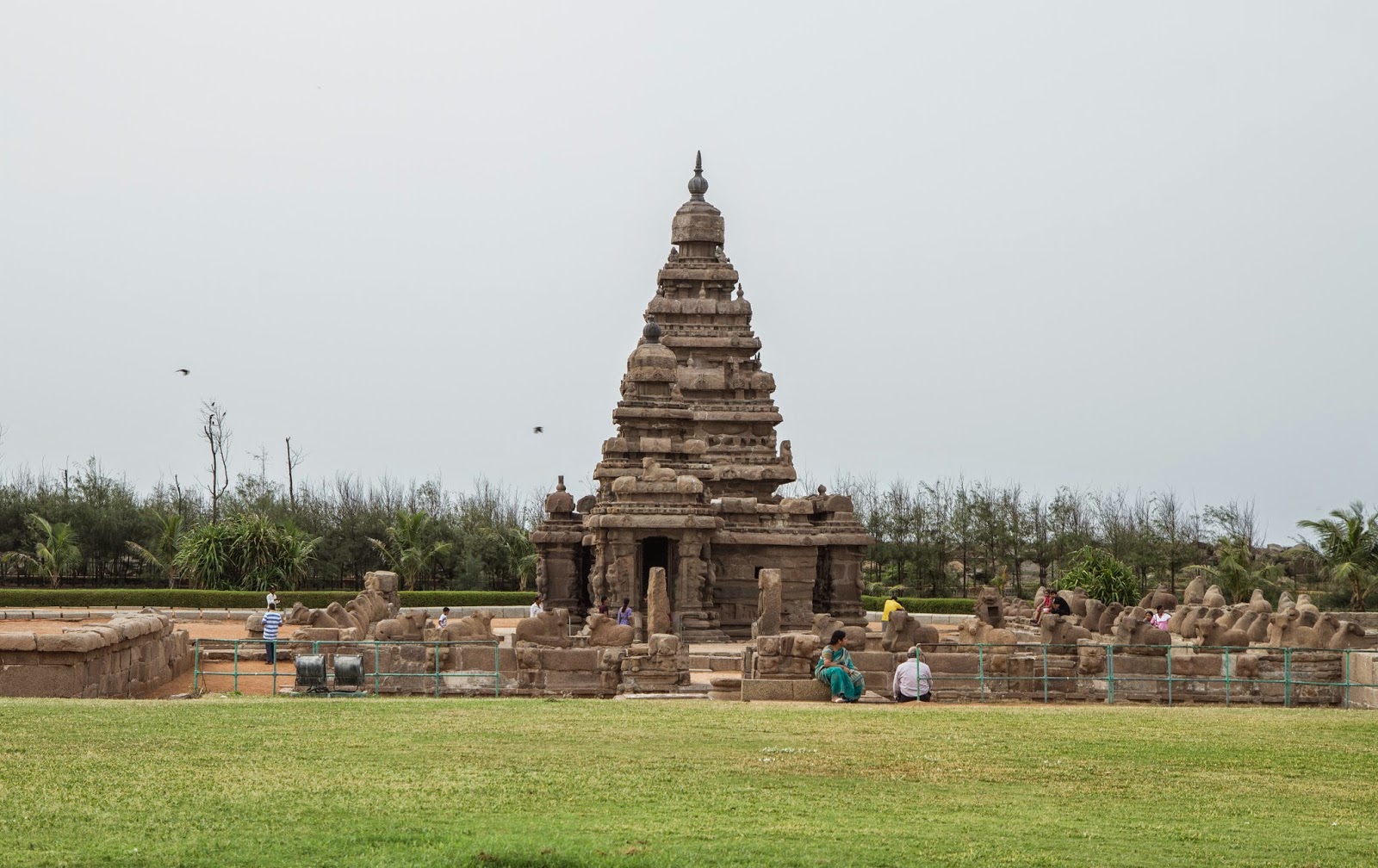Mahabalipuram was a 7th century port city of the South Indian dynasty of the Pallavas around 60 km south from the city of Chennai in Tamil Nadu. It is believed to have been named after the Pallava king Mamalla. It has various historic monuments built largely between the 7th and the 9th century, and has been classified as a UNESCO World Heritage Site.
There are three main attractions in Mahabalipuram. One is the shore temple, another is the pancharatha (pancha pandava) temples and third is Arjuna's penance.
The Shore Temple
Shore temple is a complex of three temples, one large and two small, located right on the shores of the Coromandel Coast of the Bay of Bengal in Mahabalipuram. The main temple is a five-storeyed structure dedicated to Lord Shiva and is sculpted out of granite. The key attraction of the Shore Temple are the five chariots or the Pancha Pandava Rathas, four of which are named after the Padavas and the fifth one is known as the Draupadi Ratha. Each of these Rathas is huge and distinct from the others, speaking of the aesthetic excellence of the artisans of that time.
Sunrise and sunset add to the scenic charm of the Shore temple. So it is best to visit the temple at dawn.
A monolith sculpture of a partly carved and partly sculpted lion with a hole in its torso is erected within the compound wall of the temple complex. A female guardian with a bow is also carved on the right leg of the lion.
Miniature shrine in shore temple
The entire compound wall surrounding the temples is sculpted with large sculptures of Nandi..
Arjuna's Penance is a story from the Mahabharata of how Arjuna, one of the Pandava brothers, performed severe austerities in order to obtain Shiva's weapon.
standing one-legged, arms above his head.In the center of the relief, purifying river Ganges flows down the mountain, surrounded by ascetics, celestials, elephants, and other animals on the banks.
Five Rathas (chariot)
The structures are named after the Pancha Pandavas, they are named Arjuna, Bhima, Yudhishthira ("Dharmaraja"), Nakula and Sahadeva – and Draupadi.
A complete view of Pancha Ratahas in Mahabalipuram


Elephant and Nakula Ratha
Bhima Ratha
Arjuna Ratha, Draupadi Ratha and Bull
After the Tsunami of December 2004, a collapsed temple as well as several other structures and primordial rock sculptures used in the same era to decorate walls and religious shrines were exposed. It revived theories that Mahabalipuram formed part of the Seven Pagodas the first Europeans wrote about. whole Mahabalipuram itself is a mystery with constant new discoveries.....its believed that more relic to be found under the sea..we ended the trip with nice seafood in Restaurant Moonrakers at Othavadai Street.






























1 comment:
SEMINAR ON MAHABALIPURAM - "PALLAVA MALLAI" MEANING MALLAI (as fondly called in Tamil) OF PALLAVAS :
“PALLAVA MALLAI” (Celebrating Art along with Music). It is for Two full days Dec 24 Sat & 25 Sun 2016 - 10 am to 6 pm. The Venue is Tamil Virtual Academy, Anna University Campus, Gandhi Mandapam Road, Kotturpuram, Chennai, Tamil Nadu 600025, next to Anna Centenary Library, Kotturpuram, Chennai THE coverage will be on the Overview of Mahabalipuram, History of Mallai from Sangam days and how it was rediscovered in the last 200 years, understanding the inspiration and imagination of kings from their epigraphs, how they expanded Mamallai into a gallery of scintillating sculpture and temple architecture, beginning from cave temples to structured temples. The seminar also covers the fine arts in terms of pasurams sung on Mamallai and the unique TDEF eco-system prevalent in Mallai area along with an appreciation of Sanskrit, satire, dance, song mixed with a unique presentation of Mattavilasa Prahasana, the dance drama composed by Mahendra Varma Pallava.
:::WHY YOU SHOULD ATTEND THIS ::: There’s an ocean of ignorance between the history and significance of Mamallapuram and its perception in the public mind. It was a laboratory of art and sculpture, an open-air museum patronized by a dynasty of dynamic monarchs, a granite canvas for Grantham calligraphy, a field of stone planted with immortal monuments by artists with fertile imaginations. It stands unique in its diversity of architecture. In grace, it has sometimes been equaled, but rarely surpassed. It was the epicenter of a cultural earthquake, whose aftershocks reverberated for a thousand years. Its impact spread across the land, and even crossed the oceans. But as subtle as the sculptures, are the unsolved mysteries it poses; about authorship, inspiration, incompleteness, paucity of literary references, even its influences and a later loss of imagination.
PLEASE cascade the information and all of your friend circle or whoever interested on this subject. No registration is required to attend our program and its absolutely FREE. All are welcome!
FOR any quick queries, contact Sivasankar Babu 98400 68123 or Ramki 9841489907 of the Organizing Group.
NOTE: - IF YOU CAN GIVE YOUR EMAIL ID I CAN SEND THE PROGRAMME SCHEDULE. Organised by Tamil Heritage Trust, Chennai. www.tamilheritage.in
Post a Comment